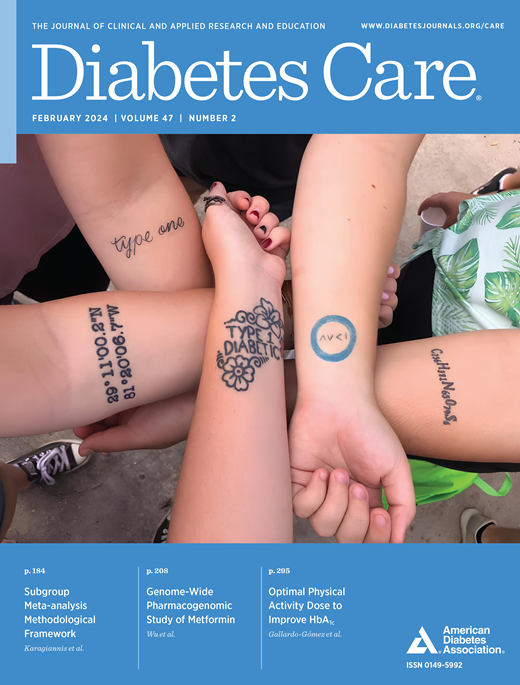Trends in Racial/Ethnic Disparities in Early Glycemic Control Among Veterans Receiving Care in the Veterans Health Administration, 2008–2019
IF 14.8
1区 医学
Q1 ENDOCRINOLOGY & METABOLISM
引用次数: 0
Abstract
OBJECTIVE Racial/ethnic disparities in glycemic control among non-Hispanic Black (NHB) and non-Hispanic White (NHW) veterans with type 2 diabetes (T2D) have been reported. This study examined trends in early glycemic control by race/ethnicity to understand how disparities soon after T2D diagnosis have changed between 2008 and 2019 among cohorts of U.S. veterans with newly diagnosed T2D. RESEARCH DESIGN AND METHODS We estimated the annual percentage of early glycemic control (average A1C <7%) in the first 5 years after diagnosis among 837,023 veterans (95% male) with newly diagnosed T2D in primary care. We compared early glycemic control by racial/ethnic group among cohorts defined by diagnosis year (2008–2010, 2011–2013, 2014–2016, and 2017–2018) using mixed-effects models with random intercepts. We estimated odds ratios of early glycemic control comparing racial/ethnic groups with NHW, adjusting for age, sex, and years since diagnosis. RESULTS The average annual percentage of veterans who achieved early glycemic control during follow-up was 73%, 72%, 72%, and 76% across the four cohorts, respectively. All racial/ethnic groups were less likely to achieve early glycemic control compared with NHW veterans in the 2008–2010 cohort. In later cohorts, NHB and Hispanic veterans were more likely to achieve early glycemic control; however, Hispanic veterans were also more likely to have an A1C ≥9% within 5 years in all cohorts. Early glycemic control disparities for non-Hispanic Asian, Native Hawaiian/Pacific Islander, and American Indian/Alaska Native veterans persisted in cohorts until the 2017–2018 cohort. CONCLUSIONS Overall early glycemic control trends among veterans with newly diagnosed T2D have been stable since 2008, but trends differed by racial/ethnic groups and disparities in very poor glycemic control were still observed. Efforts should continue to minimize disparities among racial/ethnic groups.2008-2019 年在退伍军人健康管理局接受治疗的退伍军人在早期血糖控制方面的种族/族裔差异趋势
目的 据报道,非西班牙裔黑人(NHB)和非西班牙裔白人(NHW)2 型糖尿病(T2D)退伍军人在血糖控制方面存在种族/族裔差异。本研究考察了不同种族/族裔的早期血糖控制趋势,以了解在 2008 年至 2019 年期间,在新诊断出 T2D 的美国退伍军人队列中,T2D 诊断后不久的差异发生了怎样的变化。研究设计和方法 我们估算了 837,023 名新确诊 T2D 的退伍军人(95% 为男性)在初级保健中确诊后前 5 年的早期血糖控制率(平均 A1C 为 7%)。我们使用带有随机截距的混合效应模型,比较了按诊断年份(2008-2010 年、2011-2013 年、2014-2016 年和 2017-2018 年)定义的队列中不同种族/族裔群体的早期血糖控制情况。我们估算了种族/民族群体与 NHW 早期血糖控制的几率比例,并对年龄、性别和诊断后年数进行了调整。结果 在四个队列中,在随访期间实现早期血糖控制的退伍军人的年平均比例分别为 73%、72%、72% 和 76%。与 2008-2010 年队列中的 NHW 退伍军人相比,所有种族/族裔群体实现早期血糖控制的可能性都较低。在后来的队列中,NHB 和西班牙裔退伍军人更有可能实现早期血糖控制;然而,在所有队列中,西班牙裔退伍军人也更有可能在 5 年内 A1C ≥9%。非西班牙裔亚裔、夏威夷原住民/太平洋岛民和美国印第安人/阿拉斯加原住民退伍军人在早期血糖控制方面的差异在各组群中持续存在,直到 2017-2018 组群。结论 自 2008 年以来,新诊断为 T2D 的退伍军人的早期血糖控制总体趋势保持稳定,但不同种族/族裔群体的趋势各不相同,仍可观察到血糖控制极差的差异。应继续努力将种族/民族群体间的差异降至最低。
本文章由计算机程序翻译,如有差异,请以英文原文为准。
求助全文
约1分钟内获得全文
求助全文
来源期刊

Diabetes Care
医学-内分泌学与代谢
CiteScore
27.80
自引率
4.90%
发文量
449
审稿时长
1 months
期刊介绍:
The journal's overarching mission can be captured by the simple word "Care," reflecting its commitment to enhancing patient well-being. Diabetes Care aims to support better patient care by addressing the comprehensive needs of healthcare professionals dedicated to managing diabetes.
Diabetes Care serves as a valuable resource for healthcare practitioners, aiming to advance knowledge, foster research, and improve diabetes management. The journal publishes original research across various categories, including Clinical Care, Education, Nutrition, Psychosocial Research, Epidemiology, Health Services Research, Emerging Treatments and Technologies, Pathophysiology, Complications, and Cardiovascular and Metabolic Risk. Additionally, Diabetes Care features ADA statements, consensus reports, review articles, letters to the editor, and health/medical news, appealing to a diverse audience of physicians, researchers, psychologists, educators, and other healthcare professionals.
 求助内容:
求助内容: 应助结果提醒方式:
应助结果提醒方式:


